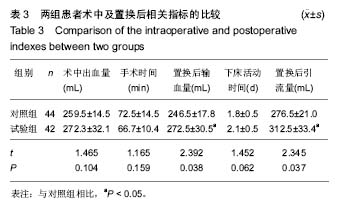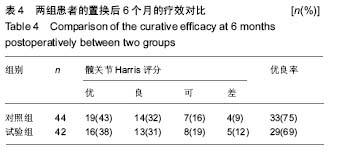| [1] Liang C, Peng R, Jiang N, et al. Intertrochanteric fracture: association between the coronal position of the lag screw and stress distribution. Asian J Surg. 2017 doi: 10.1016/j.asjsur.2017.02.003.[2] Kempegowda H, Richard R, Borade A, et al. Obesity is associated with high peri-operative complications among surgically treated intertrochanteric fracture of the femur. J Orthop Trauma. 2017 doi: 10.1097/BOT.0000000000000825. [3] Yoo JI, Ha YC, Lim JY, et al. Early rehabilitation in elderly after arthroplasty versus internal fixation for unstable intertrochanteric fractures of femur: systematic review and meta-analysis. J Korean Med Sci. 2017;32(5):858-867. [4] Yang S, Liu Y, Yang T, et al. Early clinical efficacy comparison study of gamma3 nail, percutaneous compression plate (PCCP) and femoral head replacement (FHR) treatment on senile unstable intertrochanteric fractures. J Invest Surg. 2017 doi: 10.1080/08941939.2017.1282558. [5] Sun D, Park BS, Jang GI, et al. The fixation method according to the fracture type of the greater trochanter in unstable intertrochanteric fractures undergoing arthroplasty. Hip Pelvis. 2017;29(1):62-67.[6] Sonmez MM, Camur S, Erturer E, et al. Strategies for proximal femoral nailing of unstable intertrochanteric fractures: lateral decubitus position or traction table. J Am Acad Orthop Surg. 2017 doi: 10.5435/JAAOS-D-15-00691.[7] Yoo JI, Ha YC, Lim JY, et al. Early rehabilitation in elderly after arthroplasty versus internal fixation for unstable intertrochanteric fractures of femur: systematic review and meta-analysis. J Korean Med Sci. 2017 doi: 10.3346/jkms.2017.32.5.858.[8] Wada K, Mikami H, Oba K, et al. Cementless calcar-replacement stem with integrated greater trochanter plate for unstable intertrochanteric fracture in very elderly patients. J Orthop Surg (Hong Kong). 2017 doi: 10.1177/2309499016684749.[9] Arslan A, Utkan A, Koca TT. Results of a compression pin alongwith trochanteric external fixation in management of high risk elderly intertrochanteric fractures. Indian J Orthop. 2016;50(6):636-640.[10] Resch H, Krappinger D, Moroder P, et al. Treatment of periprosthetic acetabular fractures after previous hemi- or total hip arthroplasty: Introduction of a new implant. Oper Orthop Traumatol. 2016;28(2):104-110. [11] Kashigar A, Vincent A, Gunton MJ, et al. Predictors of failure for cephalomedullary nailing of proximal femoral fractures. Bone Joint J. 2014;96-B(8):1029-1034. [12] Hoff P, Maschmeyer P, Gaber T, et al. Human immune cells' behavior and survival under bioenergetically restricted conditions in an in vitro fracture hematoma model. Cell Mol Immunol. 2013;10(2):151-158.[13] Renken F, Renken S, Paech A, et al. Early functional results after hemiarthroplasty for femoral neck fracture: a randomized comparison between a minimal invasive and a conventional approach. BMC Musculoskelet Disord. 2012;13:141. [14] Chen DW, Lin CL, Hu CC, et al. Finite element analysis of different repair methods of Vancouver B1 periprosthetic fractures after total hip arthroplasty. Injury. 2012;43(7): 1061-1065. [15] Frenkel Rutenberg T, Daglan E, Heller S, et al. comparison of treatment setting for elderly patients with hip fracture, is the geriatric ward superior to conventional orthopedic hospitalization? Injury. 2017. pii: S0020-1383(17)30277-2. [16] Zhang YM, Jiang X, Sun YS. Effect of rivaroxaban on preventing deep-vein thrombosis in aged diabetics with femoral neck fractures after hip replacement. Biosci Rep. 2017. doi: 10.1042/BSR20170289. [17] Dudko S, Kosior P, Kusz D, et al. Factors Influencing Treatment of Proximal Femoral Fractures. Ortop Traumatol Rehabil. 2017. doi: 10.5604/15093492.1235277.[18] Kumar N, Wayne-Yap MQ, Ebk K. Lumbosacral Plexopathy in Pelvic Injury - A Cause of Hip Instability in Acetabular Fractures: A Report of Two Cases. Malays Orthop J. 2016; 10(2):61-65. [19] Thakur A, Lal M. Cemented Hemiarthroplasty in Elderly Osteoporotic Unstable Trochanteric Fractures using Fracture Window. Malays Orthop J. 2016;10(1):5-10. [20] Wang Z, Bhattacharyya T. Outcomes of Hemiarthroplasty and Total Hip Arthroplasty for Femoral Neck Fracture: A Medicare Cohort Study. J Orthop Trauma. 2017. doi: 10.1097/BOT.0000000000000814.[21] Yan M, Wang B, Li Y, et al. Analysis of prosthesis-related complications after extensible semi-joint prosthesis replacement for lower limbs osteosarcoma in children. Zhongguo Xiu Fu Chong Jian Wai Ke Za Zhi. 2015;29(10): 1194-1198.[22] 吕龙,牛啸博,张剑君,等.生物型加长柄关节置换治疗高龄股骨转子问骨折[J].中华骨科杂志,2012,32(7):637-641.[23] Castilian P, Bartra A, Vallro G, et al. Hip arthroplasty with conventional stem as rescue treatment after failed treatment of intertrochanteric hip fractures. Rev Esp Cir Ortop Tranmatol. 2013;57(3):194-200.[24] Barrack RL, Mulroy RD, Harris WH. Improved cementing techniques and femoral component loosening in young patients with hip arthroplasty. A 12-year radiographic review. J Bone Joint Surg Br. 1992;74(3):385-389.[25] Brooker AF, Bowerman JW, Robinson RA, et al. Ectopic ossiflcation following total hip replacement. J Bone Joint Surg (Br). 1973;55(8):1629-1632.[26] Jensen JS,Michaelsen M. Trochanteric femoral fractures treated with McLaughlin osteosynthesis. Acta Orthop Scand. 1975;46(5):795-803.[27] Singh M, Nagrath AR, Malni PS. Changes in trabecular pattern of the upper end of the femuran index of osteoporosis. J Bone Joint Surg Am. 1970;52(3):457-467.[28] 成世高,王万春,肖扬,等.骨水泥型人工股骨头置换治疗高龄不稳定型股骨转子间骨折[J].中国组织工程研究, 2015,19(52): 8373-8378.[29] Liu GB, Zhang GP, Ren QY, et al. Classification of ankle injury on radiography and magnetic resonance imaging: study protocol for a retrospective, self-controlled, clinical trial with 3-month followup. Clin Transl Orthop. 2016;1(4):170-176.[30] Chen Y, Qu S, Ma G, Meng JH, Ni XL. Femoral nerve block prevents deep venous thrombosis of the lower extremity after knee arthroplasty: a single-center randomized controlled trial. Clin Transl Orthop. 2016;1(1):1-5. |
.jpg)



.jpg)
.jpg)
.jpg)
.jpg)